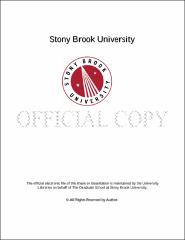| dc.identifier.uri | http://hdl.handle.net/11401/77153 | |
| dc.description.sponsorship | This work is sponsored by the Stony Brook University Graduate School in compliance with the requirements for completion of degree. | en_US |
| dc.format | Monograph | |
| dc.format.medium | Electronic Resource | en_US |
| dc.language.iso | en_US | |
| dc.publisher | The Graduate School, Stony Brook University: Stony Brook, NY. | |
| dc.type | Dissertation | |
| dcterms.abstract | The plasma membrane contains a diverse array of proteins, including receptors, channels, and signaling complexes, that serve as decision-making centers. Investigation of membrane protein topology is important for understanding the function of these types of proteins. Here, we report a method to determine protein topology in the membrane that utilizes labeling of cysteine with isotope-coded mass tags (ICMT). The mass tags contain a thiol reactive moiety, linker, and a quaternary ammonium group to aid ionization in the mass spectrometer and were synthesized as both light and heavy (deuterated) forms. The probes are membrane impermeable. To assess the utility of the probes for mapping peptide thiol topology, we employed a two-step labeling procedure. Vesicles containing α -helical transmembrane peptides were labeled with heavy (or light) probe, solubilized with detergent, and then labeled with an excess of the complementary probe. Peptides for which the cysteine was oriented in the center of the lipid bilayer were not labeled until the lipid vesicles were lysed with detergent, consistent with the membrane impermeability of the probes and reduced ionization of the thiol in the hydrophobic membrane. Peptides for which the cysteine was positioned in the headgroup zone of the lipid bilayer were labeled rapidly. Peptides for which the cysteine was positioned below the headgroup abutting the hydrocarbon region were labeled at a reduced rate compared to the fully accessible cysteine. Moreover, the effect of lipid bilayer structure on the kinetics of peptide and lipid flipping in the bilayer was readily measured with our two-step labeling method. The small sample size required, the ease and rapidity of sample preparation, and the amenability of MALDI-TOF mass spectral analysis in the presence of lipids will enable future facile investigation of membrane proteins in a cellular context. Interfacial proteins are water-soluble enzymes or regulatory macromolecules that bind transiently to the membrane surface during the course of the catalytic reaction or signaling event. The structures of the water-soluble state are often readily available to high resolution in a routine manner. However, characterizing the conformation of the active protein complex at the membrane interface is a major challenge in structural biology. Current methods rely primarily on the introduction of large, potentially structure altering, probes for EPR or fluorescence analysis, or detection of local structure by solid-state NMR spectroscopy. We are developing mass spectrometric methodology that will provide atomic resolution information about the nature of residues involved in protein-membrane binding. Cholesterol oxidase from <italic>Streptomyces</italic> <italic>sp.</italic> SA-COO was employed as a model system because it is an interfacial enzyme that is easily expressed, and detailed kinetic analyses, and crystallographic structures are available. Multiple cysteines were introduced in a single protein, and the Michaelis-Menten kinetics of these mutants showed comparable activities to wild-type enzyme. These cysteine thiols were tagged with ICMT probes, and the reaction rates depended on the solvent accessibility of the cysteine being labeled. Moderate differences in labeling rate were detected at cysteines proposed to be in membrane contact. These studies serve as the foundation for future design of experiments to explore protein-membrane interactions in more detail. | |
| dcterms.available | 2017-09-20T16:52:06Z | |
| dcterms.contributor | Boon, Elizabeth | en_US |
| dcterms.contributor | Sampson, Nicole S. | en_US |
| dcterms.contributor | Raleigh, Daniel | en_US |
| dcterms.contributor | Seeliger, Markus. | en_US |
| dcterms.creator | SU, CHIAO-YUNG | |
| dcterms.dateAccepted | 2017-09-20T16:52:06Z | |
| dcterms.dateSubmitted | 2017-09-20T16:52:06Z | |
| dcterms.description | Department of Chemistry. | en_US |
| dcterms.extent | 272 pg. | en_US |
| dcterms.format | Application/PDF | en_US |
| dcterms.format | Monograph | |
| dcterms.identifier | http://hdl.handle.net/11401/77153 | |
| dcterms.issued | 2015-08-01 | |
| dcterms.language | en_US | |
| dcterms.provenance | Made available in DSpace on 2017-09-20T16:52:06Z (GMT). No. of bitstreams: 1
SU_grad.sunysb_0771E_11750.pdf: 24000674 bytes, checksum: 2911982ad6bdc1d09a60c4b88e67018d (MD5)
Previous issue date: 2014 | en |
| dcterms.publisher | The Graduate School, Stony Brook University: Stony Brook, NY. | |
| dcterms.subject | ICMT, maleimide, mass tag, membrane protein topology, peptide, sulfhydryl | |
| dcterms.subject | Chemistry | |
| dcterms.title | Mass spectrometry-based isotope-coded mass tag (ICMT) to study transmembrane peptide dynamics and protein-lipid interactions | |
| dcterms.type | Dissertation | |

